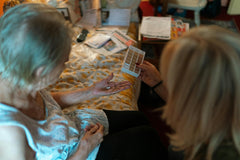Your cart is empty now.
FREE DELIVERY ON GRAB RAIL ORDERS OVER £30

Key Features of Dementia-Friendly Wardrobes, Chests of Drawers, and Bedside Tables
- 18 June, 2025
- Frederick Tomblin
Wardrobes, chests of drawers, and bedside tables are essential items in any bedroom, and when designed thoughtfully, they can help people with dementia maintain routines and feel more in control of their environment. Here are some of the key features to look for:
1. Visibility and Easy Recognition
Clear visibility is vital. Wardrobes and drawers with transparent or open-front panels allow users to see the contents without needing to open each compartment. This reduces frustration and supports memory recall. Alternatively, using pictorial or written labels on doors and drawers can help users locate items easily.
2. Contrasting Colours
Use contrasting colours between furniture and walls or floors to help the furniture stand out. Handles or knobs should also contrast in colour to the surface of the furniture to make them easier to see and use. For example, white drawers with wooden or brightly coloured handles can improve usability.
3. Simplicity in Design
Furniture should be traditional and familiar in style. Avoid modern or abstract forms, which can be confusing or off-putting. Drawer fronts and wardrobe doors should be simple and free from unnecessary decoration, making them more intuitive to use.
4. Ease of Use
Handles should be large, easy to grip, and not require fine motor skills or twisting to operate. Soft-close drawers and doors can reduce noise and avoid startling the user. Sliding wardrobe doors may be harder to manage than hinged ones, so swing doors are usually preferred.
5. Safe and Supportive Structure
Rounded corners help prevent injury from bumps. All units should be sturdy and secured to walls if needed, especially taller wardrobes and chests of drawers, to prevent tipping. A stable, weighted design provides reassurance and reduces the risk of accidents.
6. Proximity and Accessibility
Bedside tables should have open shelving or shallow drawers to keep essential items easily accessible. Keeping surfaces uncluttered and allowing space for a nightlight or clearly visible clock can help reduce confusion during the night.
By incorporating these thoughtful design elements, wardrobes, chests of drawers, and bedside tables can support people with dementia in maintaining independence and reducing stress. These small, practical choices in furniture design make a significant difference in day-to-day living.
Search
Recent Post
Archive
- June 2025



